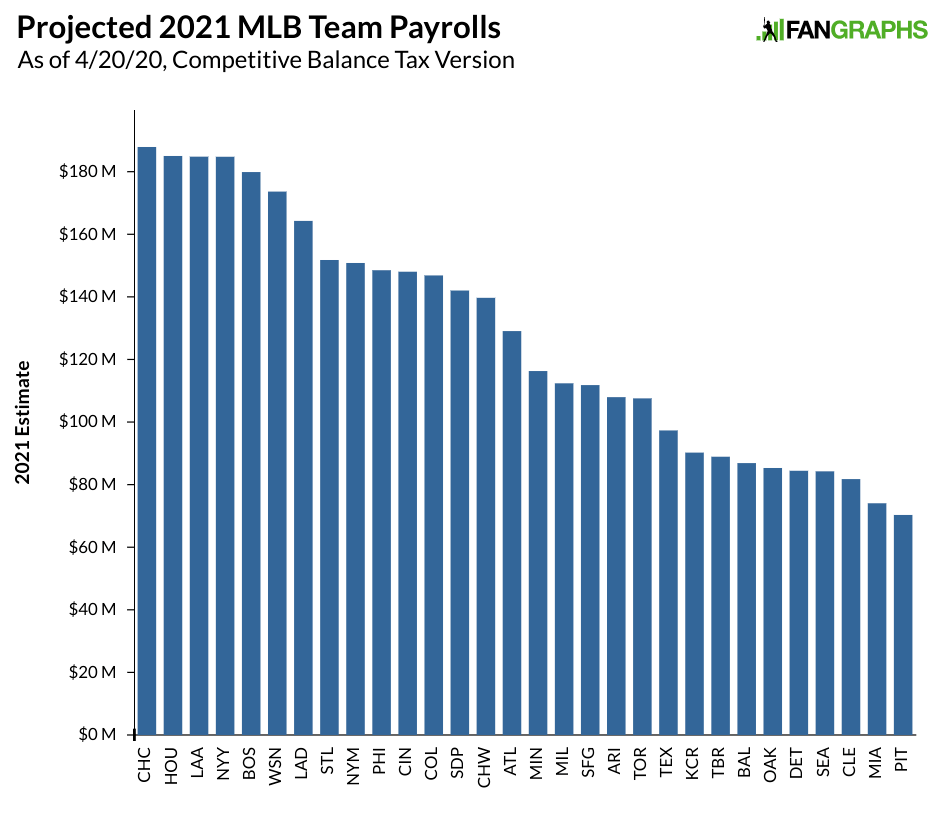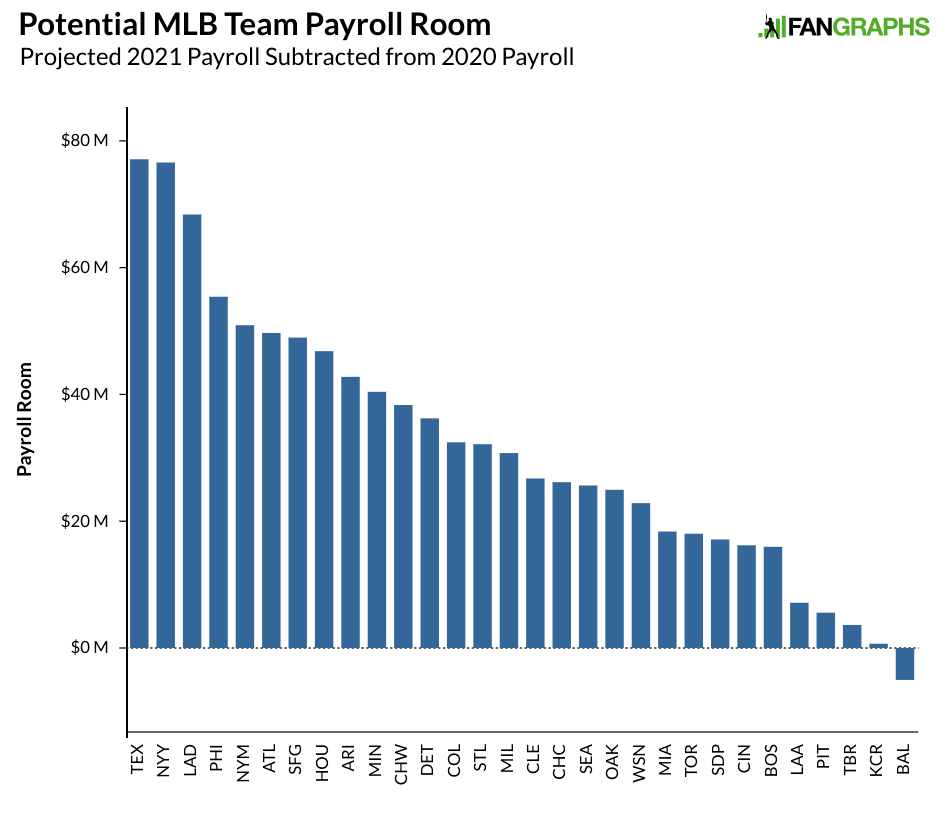Projecting Team Payrolls for the 2021 Season
What this winter’s free agent market ends up looking like — and how lucrative it proves to be for players — is unsurprisingly very much in flux. The 2020 season is still in flux, and how it plays out, or if it ends up being played at all, will have a significant affect on the offseason. If there’s no season, we know that players will still receive service time, making guys like Mookie Betts, James Paxton, and J.T. Realmuto free agents. Players will receive raises in arbitration. For competitive balance tax purposes, no season would mean no tax payments. The Red Sox would still need to stay under the $210 million tax threshold in order to reset their tax amount, though with 2021 being the final season of the current CBA between the players and owners, the ramifications of such a move are very much unknown and could end up being completely nullified by a new deal.
Ifsome version of the season does get played, there might be slightly fewer questions, but the winter will still bring about considerable uncertainty. With that in mind, and the season still a ways off, let’s take a moment to see how team payrolls are shaping up this offseason. For the graph below, I looked at competitive balance tax payrolls, which take the average annual value of contracts and include around $15 million in benefits, with a few million for 40-man players not on the active roster, as well as expected minimum salaries players. I estimated arbitration-eligible players by giving them a 50% raise over 2020 figures and for the most part, I declined club options. The only options shown as exercised below are for Adam Eaton, Starling Marte, Anthony Rizzo, and Kolten Wong. All others are presumed declined. All figures are from our RosterResource Payroll pages. If rosters remain the same with a season played in 2020, this is what we might see as payroll heading into free agency.

These figures are without trades or non-tenders of players in arbitration. The Cubs are at the top at roughly $188 million, with the Astros, Angels, and Yankees not too far behind. All told, these figures add up to $3.86 billion. That is a significant sum, but also consider that at the end of last offseason using the same methodology, the payrolls were $370 million higher. There’s simply a huge number of older, long-term contracts coming off the books at the end of this season. A busy offseason of spending last winter added $476 million to payrolls heading into 2020, an increase in total payroll of a little under 1%, but next year’s free agents are unlikely to replicate that total, which, combined with those big contracts running their course, could amount to a big drop in payroll.
Even under normal circumstances, it looked like payroll in 2021 was going to take a huge dip from previous seasons. With the roughly $850 million coming off the books unlikely to be replaced by raises in arbitration, it would take a massive free agent winter to get anywhere near 2020 figures. And while Mookie Betts is one heck of a headliner, 2020’s supporting cast, populated as it is by players like J.T. Realmuto, George Springer, Trevor Bauer, and Marcus Semien, likely won’t get teams close to last year’s spending even before we consider the fallout out from COVID-19 and its potential effects. It already seemed likely that payrolls would decrease by somewhere close to half a billion dollars in 2021, the final year of the current CBA. If spending is severely curtailed or teams are particularly aggressive with non-tenders in arbitration, the figure could be worse.
While many very good young players will go through salary arbitration, adding a degree of variability to eventual payroll numbers, the chart below shows only the guaranteed contracts with benefits, minimum salaried players, and the small amounts for 40-man players not on the roster:

The chart above isn’t useful for projecting payroll, but does show how much teams have tied up in guaranteed contracts. The Cubs are notable here because while they are first in the projected payroll graph, they are in the middle in terms of guarantees. The club will have a lot of payroll tied up in Kris Bryant, Javier Báez, and Kyle Schwarber, and the team’s $72 million in estimated arbitration salaries are more than $15 million higher than second-place Mets, who have Noah Syndergaard, Michael Conforto, Steven Matz, and Edwin Diaz, among others.
If we compare the 2021 estimated figure to 2020 numbers, we can come up with a rough figure for payroll room.

The Rangers’ figure could come down some if Corey Kluber’s option vests or they pick up the team end, but they could be big spenders next season if they choose to be. The Dodgers and Yankees have already somewhat large payrolls, but also have significant salaries coming off the books. The Yankees might need to replace three-fifths of their rotation with Paxton, Masahiro Tanaka, and J.A. Happ all free agents (Happ has a vesting option), but their salaries plus the money owed to Jacoby Ellsbury all end in 2020, while the Dodgers have Justin Turner and Mookie Betts set to hit free agency. At the bottom end of the graph are mostly small-market teams with already-low payrolls, though the Red Sox, Angels, and Reds all already have similar commitments in 2021 compared to this season.
In total, there’s somewhere close to a billion dollars in potential spending (or savings) for major league teams next year. Even before COVID-19 wreaked havoc on the world, teams were looking at significantly reduced payrolls for the 2021 season. That effect might now be exacerbated, but as payrolls lower in 2021, most of the drop can likely be attributed factors that were already present – namely, that many big contracts are set to an end in 2020, and that the last several offseasons haven’t resulted in enough new long-term contracts to fill in that gap.
Craig Edwards can be found on twitter @craigjedwards.

Thanks Craig, great info! Based on what you have stated, it seems like a given that overall spending will be down, however, with more teams having money to burn, it will be interesting to see if the big name free agents get more or less than in years past.
I don’t think anybody in 2020 has “cash to burn”.